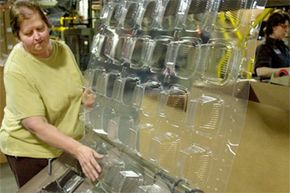In Frank Capra's classic movie "It's A Wonderful Life," Sam Wainwright encourages George Bailey to invest in the exciting world of plastics. "It's the biggest thing since radio," Sam tells George, "and I'm lettin' you in on the ground floor."
We can only imagine what Sam would have thought about biodegradable plastics, or how he would have pitched it to his old friend when scientists discovered they could make polyesters out of plants in the late 1980s. He might have said something like, "It's the biggest thing since the PC." And it was, in concept, but as is often the case with "miracle" solutions, the reality rarely lives up to the hype.
Advertisement
First, let's recap the promise of plastic made from polylactic acid (PLA), a polymer derived from plant sugars. When agricultural giant Cargill developed PLA, it touted two clear benefits. First, Cargill argued, the starting material for the polymer is corn, a crop produced by the billions of bushels every year. In other words, PLA comes from a renewable resource, unlike traditional plastic, which begins its life as oil made from fossil fuels during the refinery process. Second, PLA breaks down into water and carbon dioxide when exposed to bacteria. That makes corn-based plastic biodegradable, which makes it much more environmentally friendly.
As it turns out, producing PLA, as opposed to traditional plastic, has been better from a fossil-fuel perspective. Because it's a bio-based polymer, it doesn't require any oil as a raw material. Compare that to conventional plastic packaging, which uses 200,000 barrels of oil a day in the United States [source: Royte]. Nor does it demand as much energy -- energy that comes from coal-burning power plants -- to produce. According to some estimates, making PLA uses 65 percent less energy than producing conventional plastics [source: Royte]. That also means fewer greenhouse gases and less of a contribution to global warming.
But PLA-based packaging does require a controlled environment in order to break down. The bacteria that decompose the plastic can't do their work unless all oxygen is removed and temperatures reach at least 140 degrees Fahrenheit (60 degrees Celsius) for 10 consecutive days. In such conditions, the plastic will biodegrade in fewer than 90 days. A landfill, however, can't deliver these conditions. Neither can a typical home-composting operation. In either setting, PLA hangs around just as long as petroleum-based plastic -- 500 years or more. And PLA that makes it to recycling centers causes other problems. Recyclers can't bundle PLA with traditional plastic, so they consider it a contaminant.
Oxo-degradable plastic, another type of biodegradable plastic, isn't much better. Although it can be recycled as part of a normal plastic waste stream, it's made from a byproduct of oil or natural gas, so it still relies on a nonrenewable resource. And, as its name suggests, it decomposes best in the oxygen-rich environments provided by large industrial composting tanks, equipment not found in typical landfills or backyards.
So, given the reality of different biodegradable plastics, do we really need them? In their current forms, perhaps we don't. But that state of affairs doesn't necessarily indicate the shape of biodegradable plastic to come. In the meantime, recycling programs could be tweaked to accommodate corn-based biodegradable plastic, perhaps expanding to a three-bin recycling collection system: one for traditional plastics, one for biodegradable plastics, which would be delivered to a commercial composting facility, and one for whatever is left.
That may not seem very exciting to get-rich-quick entrepreneurs like Sam Wainwright, but it's a step in the right direction.
Advertisement

